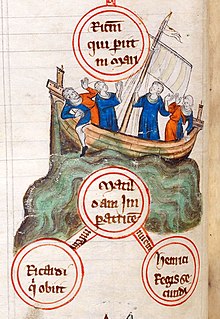White Ship

The White Ship (French: la Blanche-Nef), a twelfth-century vessel, sank in the English Channel near the Normandy coast off Barfleur, on 25 November 1120. Those drowned included William Adelin, the only legitimate son of King Henry I of England. William of Malmesbury wrote: "Here also perished with William, Richard, another of the King's sons, whom a woman without rank had borne him, before his accession, a brave youth, and dear to his father from his obedience; Richard d'Avranches, second Earl of Chester, and his brother Otheur; Geoffrey Ridel; Walter of Everci; Geoffrey, archdeacon of Hereford; the Countess of Chester; the king's niece Lucia-Mahaut of Blois; and many others ... No ship ever brought so much misery to England." Only one of those aboard survived.[1][2]
Shipwreck
The White Ship was a new ship owned by Thomas FitzStephen, whose father Stephen had been sea captain for William the Conqueror when he invaded England in 1066. He offered to let Henry I of England use it to return to England from Barfleur. Henry had already made travelling arrangements, but suggested that his son William Adelin travel on it instead.
But when the White Ship set off in the dark, its port side struck a submerged rock (this rock can still be seen from the cliffs of Barfleur), and the ship quickly capsized. The only known survivor was a butcher from Rouen. He was wearing thick ramskins that saved him from exposure, and was picked up by fishermen the next morning.
In his account of the disaster, chronicler Orderic Vitalis claimed that when Thomas FitzStephen came to the surface after the sinking and learned that William Adelin had not survived, he let himself drown rather than face the King. The accuracy of this account is doubtful—it describes a full moon, but NASA sky tables, which include adjustments based upon the Gregorian Calendar to the Julian Calendar in use during the twelfth century, show that the moon was actually new that night.
The cause of the shipwreck remains uncertain. Various stories surrounding its loss feature a drinking binge by the crew and passengers (it is also suggested that the captain was dared to try to overtake the King's ship ahead of them), and mention that priests were not allowed on board to bless the ship in the customary manner. However, the English Channel is a notoriously treacherous stretch of water.
William of Nangis wrote that the White Ship sank because all the men aboard were sodomists,[3] which reflects the medieval belief that sin caused pestilence and disaster.[4]
Repercussions
Stephen of Blois, King Henry's nephew by his sister Adela, had allegedly disembarked just before the ship sailed. Orderic Vitalis attributes this to a sudden bout of diarrhea. As a direct result of William's death, Stephen later usurped the English throne, resulting in the period known as the Anarchy. The English barons were reluctant to accept Matilda as queen Regnant, causing Stephen to usurp the throne.
Robert Lacey has observed that "The White Ship was the Titanic of the Middle Ages, a much-vaunted high-tech vessel on its maiden voyage, wrecked against a foreseeable natural obstacle in the reckless pursuit of speed,".[5]
Historical fiction
The sinking of the White Ship is the opening to the prologue of Ken Follett's most popular novel The Pillars of the Earth (1989). The ship's sinking sets the stage for the entire background of the story, which is based on the subsequent civil war between Matilda (referenced as Maud in the novel) and Stephen. In Follett's novel, it is implied that the ship may have been sabotaged.
It is also described in detail by Sharon Kay Penman in the historical novel When Christ and His Saints Slept (1994).
The ship is also referenced in Geoffrey Hill's poem "The White Ship" in For the Unfallen.
The sinking of the White Ship is briefly referenced in Glenn Cooper's novel The Tenth Chamber (2010).
The "White Ship" also sets the stage for the novel Hiobs Brüder (The Brothers of Job) by the German author Rebecca Gable, which details the rise of Henry II, son of Empress Matilda.
Poetry
- Dante Gabriel Rossetti, "The White Ship: a ballad"; first published 1881 in his collected "Ballads and Sonnets".
- Geoffrey Hill, "The White Ship". In his first book, "For the Unfallen", 1959.
Images
Notes
- ^ A section of William of Malmesbury's account of the White Ship is in Douglas, D.C. and Greenaway, G.W. (eds) English Historical Documents vol. II, no.8 (London: E. Methuen; New York: Oxford University Press, 1979)
- ^ A collated account is included in Life of Matilda of Scotland at 1066: Medieval Mosaic
- ^ ’’Chron.’’ in Rolls series, ed. W. Stubbs (London, 1879), vol. 2, under A.D. 1120.
- ^ Codex Justinian, nov. 141
- ^ Lacey, Great Tales from English History (2003)
References
- Victoria Chandler, "The Wreck of the White Ship", in The final argument : the imprint of violence on society in medieval and early modern Europe, edited by Donald J. Kagay and L.J. Andrew Villalon (1998)
- Robert Lacey, "Henry I and the White Ship" in Great Tales from English History (2003)
External links
- Britannia.com The Wreck of the White Ship
- T Brett-Jones, "The White Ship Disaster" (pdf file) [Broken link]
- Robert Lacey, "Henry I and the White Ship"
